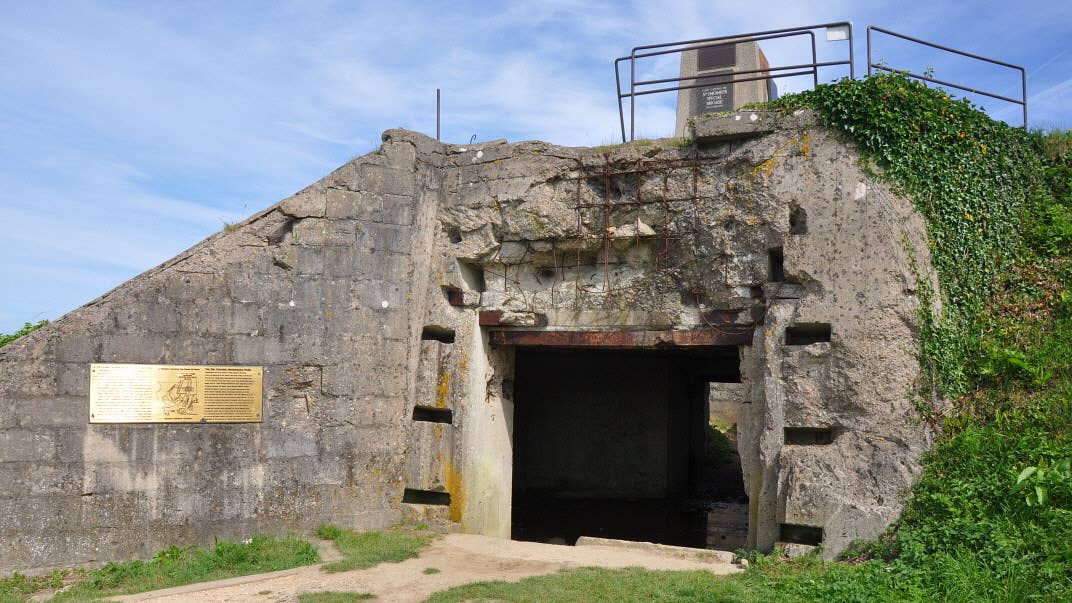The German rehearsal that doomed Omaha Beach attackers

Top Casement of WN-62, with the memorial honoring 5th Engineer Brigade.
SUMMARY
At D-Day, Allied forces had superiority of fire thanks to Navy ships offshore, air superiority, and three-to-one ratio of forces. While it took great courage to climb into the landing crafts, the odds of success at Normandy were actually good. But forces assigned to the infamous Omaha Beach faced a stacked deck. And two coincidences that intel and planners missed made it worse.
First, a recently arrived, well-trained, veteran grenadier regiment held the naturally strong defensive positions overlooking the beach. Planners knew about the bluffs, but it's disputed whether attacking officers knew about the grenadier regiment. Second, the regiment and its larger division were in the middle of anti-invasion training.
The men of the 352nd Infantry Division and its 726th Grenadier Regiment received almost exactly the fight that they expected.
The divisions guarding Fortress Europe
German forces at Normandy lacked a certain Je ne sais quoi. Maybe they lacked adequate training. Or maybe they lacked volunteer and professional soldiers. Perhaps they lacked adequate equipment and ammo. Or maybe it was vehicles. Armor, maybe?
Actually, we know exactly what they lacked, and it was all of the above. "Static" units composed of conscripts from captured territory and infirm Germans made up the bulk of the defenders. And they worked with old equipment and had few vehicles.
But one regular division, the 352nd, received orders in March 1944 to what would become Omaha Beach.
The men arrived over the next few weeks. And while they also had many struggles, they were better equipped and trained than the forces they reinforced.
The 352nd was an early Type 44 division. These had fewer men but firepower to make up the gap, an NCO corps filled with veterans of the Eastern Front, and many officers with combat experience as well. The 352nd, specifically, had an officer corps with about half combat veterans. And, its 9,650 junior enlisted soldiers were young and malnourished, but that still left them physically more capable than most static division soldiers.
So, not the best, but the best Germany had, anyway.
The Germans relive their rehearsal on D-Day
The gray morning of June 6 was supposed to be too stormy for anyone to land. But German defenders received the news of an Allied attack before sunrise. Soldiers of the 726th rushed into position and prepared for combat as the sky slowly lightened.
One of the most effective defenders was the "Beast of Omaha," Hein Severloh, a machine gunner who guarded an observation post. He looked out over a stretch of beach barely 100 yards long from his bunker to the water. As the tide rose that morning, it would get shorter and shorter.
He stood in the exact position he'd recently trained at, behind an MG-42 machine gun at the bunker WN 62. Beside him, his lieutenant called for fire onto pre-registered positions on the beach. Their only major surprise was that they were killing Americans. They had expected to kill Brits.
At least three other machine guns encircled the beach that morning, with hundreds more riflemen able to pour fire on everyone who made it out of the landing crafts alive. While the other machine guns either failed or went quiet as their gunners were hit, Severloh fought for most of the day, only retreating when his lieutenant ordered him to fall back.
The fire from the 762nd was so intense that Army Gen. Omar Bradley considered evacuating the beach.
Severloh fired all 12,000 of his normal machine gun rounds and a number of tracer rounds before the slow approach of Sherman tanks, Allied infantry, and increased naval artillery threat forced him to take the gun and scramble for high ground.
The end of the 762nd defense
Very soon after, American troops effectively cut off escape from the beach. Severloh and one other member of his team made it out, but a burst of fire inflicted flesh wounds on them.
Many soldiers from the 352nd Division and its 762nd Regiment were killed, captured, or forced back alongside the rest of the German forces as Shermans made it inland and Rangers climbed Pointe du Hoc.
As for Severloh, he fled to a nearby unit and joined them in their withdrawal with American prisoners. But, as they were again surrounded, the Germans had to surrender to their own prisoners to prevent a more violent capture by armed Americans.
The 762nd Regiment and 352nd Division got the exact fight they had prepared for, but the overwhelming success of Allied forces in setting the conditions for battle from 1943 to 1944 still ensured the success of the Allied cause.
And, in an odd quirk of history, while those men got the exact battle they had prepared for, division and regimental leaders across the front actually headed to an exercise the morning of June 6. Those leaders struggled to reach the fight in all of the chaos.
One actually drove back to his headquarters and died to a burst of machine gun fire from the paratroopers who had already captured it. Another spent the morning reaching his unit and then marching back and forth between reported Allied positions, never quite reaching the fights he was looking for. But British tanks found him that afternoon and killed him while overrunning the assembly area.
SHARE
